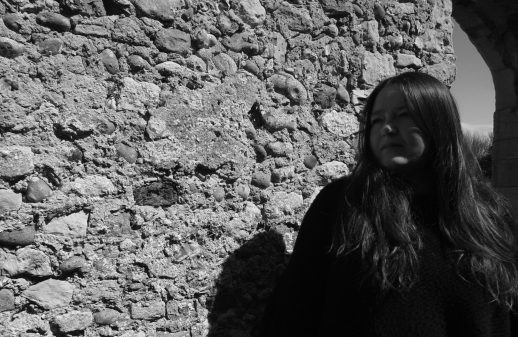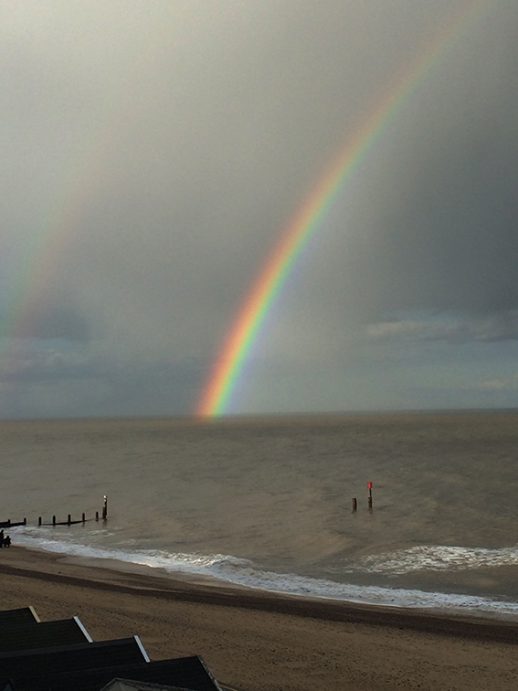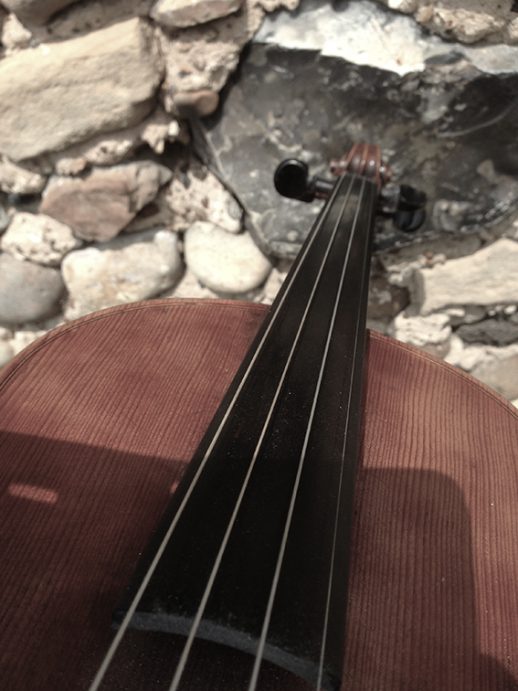An insight into the month of May from experimental medieval fiddle and recorder player Laura Cannell

May begins away from my native East Anglia, waking up on the first of the month in Manchester and remembering to say white rabbit three times before engaging in the day ahead. I was staying at Islington Mill artists B&B, ahead of my performance that evening. A plump sparrow chick on its first day of flight hopped in through the door and sat squatly, unaware of the dangers of a swinging door and a hungry cat. I was glad to see a creature in this brick heavy ex-industrial landscape. Eventually it had another go and lumpily flew up and out.
The past couple of months had been a blur of travelling, composing, performing, interviews, improvising and more travelling, playing at the Barbican followed by festivals in Glasgow, Blackpool, Wales and Manchester. Sometimes it just works out that everything is on the opposite side of the country. But this does mean a lot of staring out of train windows spotting marsh pigs, spring lambs, spike tethered and free roaming common-land ponies, all accompanied by the various drones which permeate our ears as we travel. The snow capped mountains of north Wales are still in my mind, visible from the vast beach at Prestatyn. All nature seemed to have been removed in favour of plastic, bright lights, noise, tans and otherworldliness in Blackpool.
During some months nature seems slow on the uptake, and I remember living in cities and not noticing everything change. But May in East Anglia is an explosion of undergrowth, banks of towering cow parsley, swaying hissing reeds and every leaf imaginable. The air is thick with invisible flecks of pollen, rural houses are swallowed whole by greenery. Until just over a year ago I lived under a spinney which would consume the daylight from 2pm, leaving us permanently in the shade. I longed for the sun. Now I live by the sea and find myself missing the towering pines and oaks. My sister’s house, an idyllic gingerbread house in the woods, is almost pitch black inside from May to October, while outside the garden blooms and the birds never stop telling stories. The light and shade unavoidably permeate creativity. Bright grey days with an indecisive outlook are perfect for me.
Here by the sea, Mr & Mrs Blackbird are the kings and queens amongst the seagulls. They sing their conversations, reiterating their point of view. I am imagining their voices notated as baroque recorder music, like the melodies in The Bird Fancyer’s Delight from 1717: a collection of short pieces composed for specific birds to learn. There was a small industry for flageolet or recorder players to teach a classroom of caged birds the melodies and sell them pre-programmed for lovers to give as gifts. A living mixtape. I’ve often duetted with the wildlife in the garden. In Norwich I had a regular musical collaboration with a blackbird.
It’s high seagull nesting season with fat birds promenading up and down the road, gathering moss and garden foliage and using tourist cars as runways. Speckled grey and white birds are launching themselves all over the beach. I don’t think the seagulls are interested in learning melodies from 1717. They fly away when I practice but the blackbirds and robins come closer.
At the beginning of the month I was asked to contribute to the BBC 6Music programme The Freakier Zone with Stuart Maconie: an hour-long programme exploring experimental strings. Bowed strings have the ability to cut through decades and centuries and transport the listener to a wildly ancient space. The vibrations of the strings when struck by the bow are akin to spinning plates… strike it to maintain movement at all times.
I discuss Richard Skelton’s strings with Stuart. His buried instruments are exhumed from the earth and recorded in their decaying state. Something of Contagious Magic is at work, an impulse he followed and later found to be an ancient folkloric tradition. The Iceni would bury swords in this area to gain strength from the land.
On a short trip to search out new environments to play in, I was shown inside an aircraft Hangar at Bentwaters in Suffolk. I tried a few notes and some overbowed violin and it swirled into a naturally amplified one-person chamber orchestra, sounding like 24 violins.
But this may be the most profound pleasure of May for me: a storm presenting two double rainbows converted the North Sea into a massive watery stage. I could see where the pots of gold should be, just out of reach beneath the waves.

Throughout April, May and June I am part of the project Mythos of Violins, funded by the PRS Foundation’s Beyond Borders. One of the stipulations is that it takes place in three UK countries, and I am working with Welsh violinist Angharad Davies, taking in our extreme east and west upbringings with a trip to St Peter’s Seminary in Glasgow to explore our mutual connection to the violin in familiar and new environments.
The May edition involved several days exploring the landscape, ruins and general atmosphere of the East Suffolk Coast around Southwold, Covehithe, Dunwich and Halesworth. We walked up the cliff path in Dunwich with our violins on our backs, past the last remaining headstone to the ruins of Greyfriars Friary. There we stood listening and imagining this once flourishing settlement which, through battering storms, has only a handful of houses left.
In the ruins of Greyfriars Friary to an audience of two, plus various silent walkers, several birds and numerous hidden apparitions, we opened our cases and played long exploratory notes. Standing between the two free-standing medieval walls of what was the refectory, we slowly moved around, tuning in to the slow decay of the building. At one point I rested the scroll of my fiddle on a flat piece of flint and the vibration shocked me so much that I physically jumped backwards. Was the wall expelling the music? Or perhaps waking from a long, silent slumber, where the only sounds have been the crashing waves beneath the cliff?

Driving through the Blyth Valley to perform Mythos of Violins, the cows are silhouetted against the bright May sky and marshland. They look tall on the lowlands. It’s Harry Becker in real-time, looking at places he sketched and knowing that the landscape hasn’t changed on this stretch in 50 or 500 years. The concert finished at twilight. I composed a piece for the lost bells of Dunwich which involved three violins striking open strings antiphonally, creating echoes from the lost bell towers which remain under the sea – a few metres from shore but centuries between us.
The main pleasure of May is that I am reminded of how much appears from nowhere, how much must have been secretly brewing beneath the surface while seeming silent and dormant.
Laura Cannell plays our stages at Port Eliot Festival in July, Caught by the River Thames in August and The Good Life Experience in September.